
Johan Christian Fabricius was a Danish zoologist, specialising in "Insecta", which at that time included all arthropods: insects, arachnids, crustaceans and others. He was a student of Carl Linnaeus, and is considered one of the most important entomologists of the 18th century, having named nearly 10,000 species of animals, and established the basis for the modern insect classification.

The Cape longclaw or orange-throated longclaw is a passerine bird in the family Motacillidae, which comprises the longclaws, pipits and wagtails. It occurs in Southern Africa in Zimbabwe and southern and eastern South Africa. This species is found in coastal and mountain grassland, often near water.

Dynastes tityus, the eastern Hercules beetle, is a species of rhinoceros beetle native to the Eastern United States. The adult's elytra are green, gray or tan, with black markings, and the whole animal, including the male's horns, may reach 60 mm (2.4 in) in length. The larvae feed on decaying wood from various trees.

Efferia aestuans is a species of insect in the family Asilidae, the robber flies. It is native to eastern North America, where it ranges from Ontario and New Hampshire south into Florida and New Mexico. It was originally described as Asilus aestuans in Carl Linnaeus' 1763 work Centuria Insectorum.

Eudocima phalonia, the common fruit-piercing moth, is a fruit piercing moth of the family Erebidae. The species was first described by Carl Linnaeus in his 1763 Centuria Insectorum. It is found in large parts of the tropics, mainly in Asia, Africa and Australia but introduced into other areas such as Hawaii, New Zealand and the Society Islands. It is one of major fruit pests in the world.

Centuria Insectorum is a 1763 taxonomic work by Carl Linnaeus, and defended as a thesis by Boas Johansson; which of the two men should for taxonomic purposes be credited with its authorship has been the subject of some controversy. It includes descriptions of 102 new insect and crustacean species that had been sent to Linnaeus from British America, Suriname, Java and other locations. Most of the new names included in Centuria Insectorum are still in use, although a few have been sunk into synonymy, and one was the result of a hoax: a common brimstone butterfly with spots painted on was described as the new "species" Papilio ecclipsis.

Catopsilia scylla, the orange migrant or orange emigrant, is a species of butterfly that lives in South East Asia and Australasia. Its larvae feed predominantly on plants of the genera Cassia and Senna.
Conchaspididae is a small family of scale insects known as false armoured scales because of their resemblance to Diaspididae.
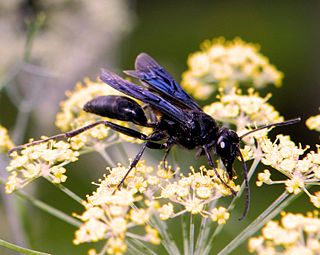
Sphex pensylvanicus, the great black wasp, is a species of digger wasp. It lives across most of North America and grows to a size of 20–35 mm (0.8–1.4 in). The larvae feed on living insects that the females paralyze and carry to the underground nest.
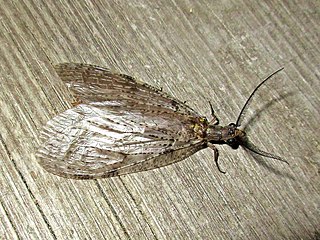
Chauliodes pectinicornis known as Summer fishfly, is a species of fishfly from North America.
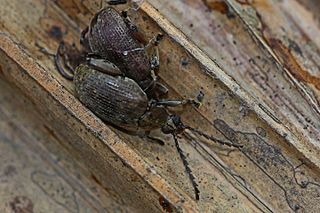
Caryobruchus gleditsiae is a species of beetle in the family Chrysomelidae. It lives in North and Central America and develops inside the seeds of palm trees. Adults grow to a maximum length of 11 mm (0.43 in), the size depending on the size of the seed it grew up in. The species was first described by Carl Linnaeus in his 1763 Centuria Insectorum.
Pseudophasma brachypterum is a species of stick insect found in Brazil, Suriname, Guadeloupe and Peru.
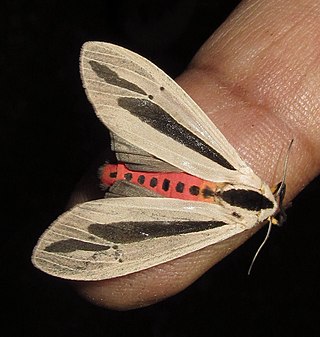
Creatonotos gangis is a species of arctiine moth in South East Asia and Australia. It was described by Carl Linnaeus in his 1763 Centuria Insectorum.
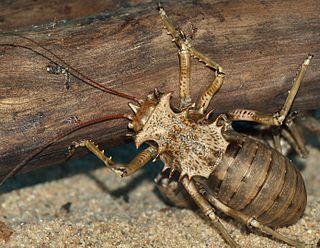
Eugaster spinulosa, a species of bush-cricket from Morocco.
Nemognatha chrysomeloides is a species of oil beetle (Meloidae) endemic to Central and South America.

Cethosia cydippe, the eastern red lacewing, is a species of butterfly from Australia, New Guinea and nearby islands. The Australian subspecies, C. c. chrysippe, is known as the red lacewing butterfly.

Metaleptea brevicornis, the clipped-wing grasshopper, is a species of grasshopper from North America.
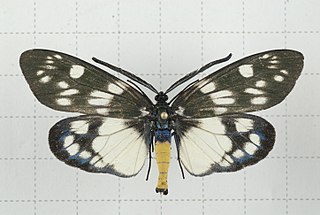
Eterusia aedea, the red slug caterpillar, is a species of moth in the family Zygaenidae. It was described by Carl Linnaeus in his 1763 Centuria Insectorum. It is found in Sri Lanka, India, Nepal, Taiwan, Japan and China.
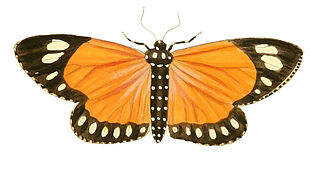
Scopula helcita is a moth of the family Geometridae first described by Carl Linnaeus in his 1763 Centuria Insectorum. It is found in Cameroon, the Republic of the Congo, the Democratic Republic of the Congo, Equatorial Guinea, Ghana, Nigeria, Sierra Leone, South Africa and Uganda.
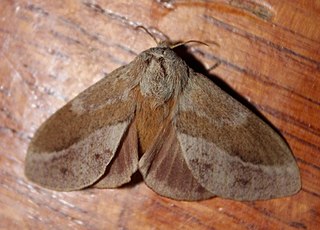
Eutricha capensis, the Cape lappet moth, is a species of moth in the family Lasiocampidae primarily found in South Africa. During the larval stage, Cape lappets feed on a wide variety of African plants and can often be found aggregating in gardens. The caterpillars are brightly coloured and conspicuously hairy, while the bulky adult moths are mostly brown and much less striking in appearance.
















